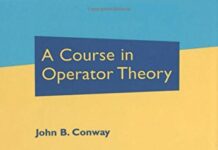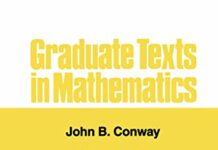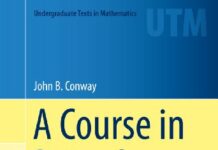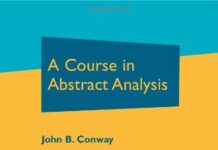
Ebook Info
- Published: 1995
- Number of pages: 412 pages
- Format: PDF
- File Size: 11.91 MB
- Authors: John B. Conway
Description
This book discusses a variety of problems which are usually treated in a second course on the theory of functions of one complex variable, the level being gauged for graduate students. It treats several topics in geometric function theory as well as potential theory in the plane, covering in particular: conformal equivalence for simply connected regions, conformal equivalence for finitely connected regions, analytic covering maps, de Branges’ proof of the Bieberbach conjecture, harmonic functions, Hardy spaces on the disk, potential theory in the plane. A knowledge of integration theory and functional analysis is assumed.
User’s Reviews
Reviews from Amazon users which were colected at the time this book was published on the website:
⭐Complex analysis is an old and very important part of mathematics, and it has very important applications in engineering (circuit theory) and pure science (quantum mechanics is formulated in an inherently complex formalism). There are a number of very great and important texts in this area. Ahlfors book has been the greatest textbook for a very long time, and it remains a great and even indispensable text. Berenstein and Gay have a ponderous two volume work that gives stunning insight and a very modern perspective. It is also the very best book for those who hope to transition to the theory of several complex variables. So, it is important, and I would not want to be without BG. BG is ponderous to use as a textbook, unless you have a rigorous graduate course. Carrier, Krook, and Pearson is an important and always useful book for giving insight into how calculations are really done. Needham is unique in that it gives the greatest insight into the underlying geometric meanings of complex analysis. I find many other texts, even those used at most excellent universities, to be of secondary importance.For me, Conway is the best place to begin, the best place to learn, and always a useful and clear reference. He arranges the curriculum in a very orderly way, in a way that allows real insight all along. His proofs are real proofs. He doesn’t leave gaps that a student should not bridge easily, and his proofs are complete. They leave no room for objections. So, the text has complete clarity. Conway gives a full skill set. Carrier Krook and Pearson may get you calculating more quickly and with greater facility, but you will learn the full calculation skill in Conway. Conway is quite complete, but without being as ponderous as BG (still a magnificent book). He gives less startling geometric insight than Needham, but he gives good insight. From my own point of view, Conway is the indispensable core book. If I were teaching the class, I would not teach it without using Needham as a co-text. Needham gives such careful insight that I would not call it a secondary text. It is a co-text. If Needham has a weakness, it is that some proofs are less stodgy and formal than I might like. Needham gives much greater depth into some very useful topics (fractional linear transformations, non-Euclidean geometry), but is lighter on details that students of a very classical area might be expected to have bumped into. Liking things stodgy is not necessarily a virtue. Needham’s demonstrations are true, useful, and convincing.With Conway, you can get the whole course with complete and correct details, and you can get it in the most straightforward and well organized way possible. It will just speed you on your way to perfect mastery of complex analysis in a single variable. In two volumes, you will need a full year course.
⭐I used this text for supplementary material in a Complex course. Text is clear and proofs are provided in great detail. Conway’s treatment is a modern improvement of Ahlfors’ great classic and covers more material.
⭐Good
⭐This book was the recommended textbook for a course in Complex Analysis I took at college. I had already done a 1st course on analysis, but that didn’t help me too much. This book, littered with loads of proofs and lemmas, is a little too terse, and the author expects students to understand a lot on their own. Concepts in Complex Analysis need to be demonstrated using examples, and diagrams, if possible. Like for eg. the concept of branches in complex functions. The book starts of defining the complex logrithmic function. The author never says what a branch exactly is. He writes down a hell lot of proofs and expects the student to figure out that the complex logarithm is infact a multi-valued function, and that a branch is essentially a “slice” of this multivalued function. Similiar problems crop up when the author discusses fractional linear transforms. Instead of showing whats happening with simple diagrams, the author makes things look extremely complicated with his equations and theorems. This book makes learning complex analysis a very mechanical exercise, devoid of all fun.
⭐Very good book.
Keywords
Free Download Functions of One Complex Variable II (Graduate Texts in Mathematics, Vol. 159) (Graduate Texts in Mathematics, 159) 1st Edition in PDF format
Functions of One Complex Variable II (Graduate Texts in Mathematics, Vol. 159) (Graduate Texts in Mathematics, 159) 1st Edition PDF Free Download
Download Functions of One Complex Variable II (Graduate Texts in Mathematics, Vol. 159) (Graduate Texts in Mathematics, 159) 1st Edition 1995 PDF Free
Functions of One Complex Variable II (Graduate Texts in Mathematics, Vol. 159) (Graduate Texts in Mathematics, 159) 1st Edition 1995 PDF Free Download
Download Functions of One Complex Variable II (Graduate Texts in Mathematics, Vol. 159) (Graduate Texts in Mathematics, 159) 1st Edition PDF
Free Download Ebook Functions of One Complex Variable II (Graduate Texts in Mathematics, Vol. 159) (Graduate Texts in Mathematics, 159) 1st Edition




